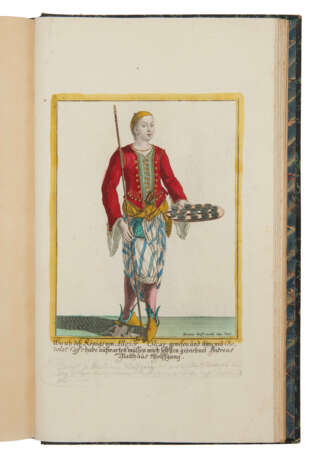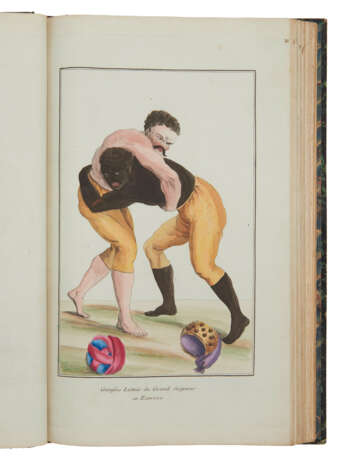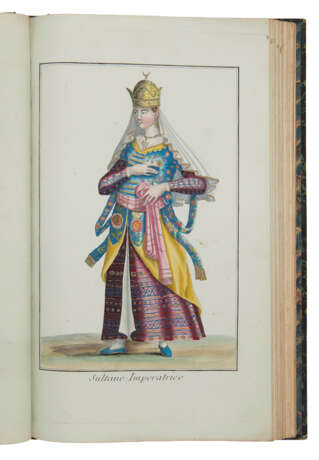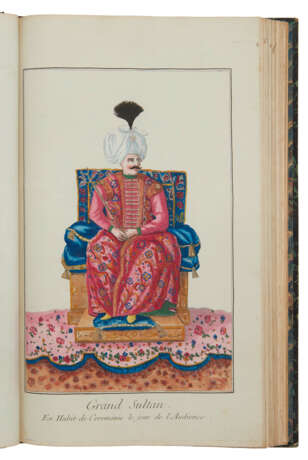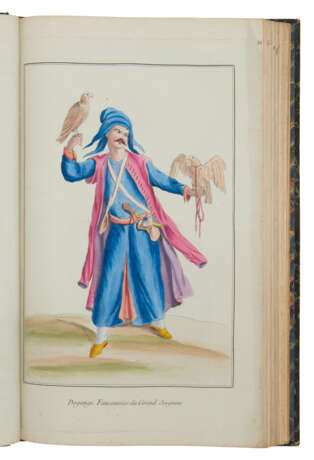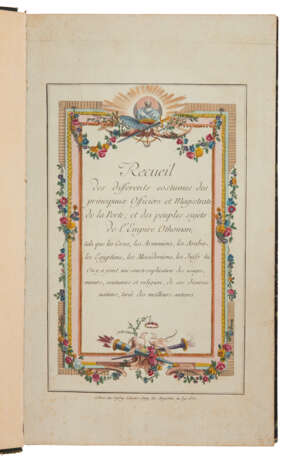ID 1105616
Lot 92 | TURKISH COSTUME
Valeur estimée
£ 25 000 – 35 000
Recueil des differens costumes des principaux officiers et magistrats de la porte; et des peoples sujets de l'empire othoman. Paris: Onfroy, [1775]. [Bound with:] [WOLFGANG, Andreas Matthäus (1660-1736). Die algierische Hofstaat, dabei die beiden Brüder Wolfgang im Sclavendienst. Augsburg: Jeremias Wolff, c. 1701].
Two extremely rare works bound in a single volume: the first work illustrating the costume of the Ottoman court and the Ottoman empire, almost certainly assembled in Paris in celebration of the enthronement of Sultan Abdul Hamid I (Abd al-Hamid, Sultan 1774-1789); the second work recording the costumes and people of Algiers by the artist Andreas Matthäus Wolfgang (1660-1736), who was sold into slavery, along with his brother, and held in Algiers from 1684-1691.
The first work within this collection demonstrates how the French, along with many other European powers, were fascinated by the hierarchical arrangements of Ottoman Society and the etiquette of the various strata particularly in their dress. The author or editor of this work is unknown; perhaps the publisher Onfroy was also the editor. A few plates identify the artist and the engraver as Pitre and Juillet respectively. The plates depict the costume of the Ottoman court and military functionaries in detail and also that of the fourteen 'nations'. The work is divided into sections, each devoted to the costume of the different orders of society; they range from the Sultan and his close court to those from the more distant parts of the Empire, such as North Africa. This work develops the 16th-century imagery of Nicolas de Nicolay and the Blackmer catalogue considered that about a third of the plates were based on Nicolay prototypes, taken from his book of Turkish costume. Blackmer 1399; Bobins I, 127; Colas 2501.
The second work bound in this folio is a product of the artist's, Andreas Matthäus Wolfgang, experience as a slave in Algeria. Andreas was born in Augsburg in 1660, and was trained to be an engraver by his father, Georg Andreas Wolfgang the Elder, who sent both him and his brother to England for further training. However, on their return to the continent in 1684, the brothers were captured by Algerian pirates and subsequently sold as slaves. The present suite includes a self-portrait of the artist serving chocolate and coffee while in the service of the Bey of Algiers, wearing traditional costume. The two brothers were only released once a ransom was paid, probably in 1691. Following his return from Algiers, Andreas settled in Augsburg and lived there until his death in 1736. Some of the etchings present are dated 1701 in the plate. The Liechtenstein Collections contain a suite of 16 plates, of which only 6 are coloured, and are ascribed dates from 1701-1710. It should be noted that the Liechtenstein suite matches 14 of the plates present in this lot, containing 2 plates not present here, but without 'Conterfan dess Mezomorto gewesten Daÿ in Algier' and 'Solimann ein verschnidner über des Königs von Allgier' found in this lot. The British Museum holds only 4 uncoloured prints from the suite. Nagler, Neues allgemeines Künstler-Lexikon, p.60.
2 works in one volume, folio (380 x 227mm). First work: contemporary hand-coloured engraved title, engraved plate list and 16 leaves of engraved text within borders, 95 (only, of 96) finely contemporary hand-coloured engraved costume plates, all within borders, and heightened with touches of gilt and silver, a few signed Juillet after Pitre (lacking plates 88 'Femme Turque d'Andriople' and 96 'Femme d'Alger avec ses enfants', but with plate 14 'Le Moufti Commandant des Mosquées' in duplicate in two variants, one on smaller paper and loosely inserted with additional title of 'Officier du Divan' and 7-line explanatory text below, the whole within wide engraved border, the other with border matching the majority, additional title 'Et Chef de la Loi' as per Blackmer's listing, and without explanatory text; occasional faint spotting, but mostly fine and clean). Second work: 16 engraved plates after Wolfgang by Jeremias Wolff, all finely contemporary hand-coloured and heightened in gold, within frames highlighted in yellow (some light show-through and faint plate tone). Early 20th-century green quarter morocco, flat spine in six compartments, lettered in gilt in the second, the others each decorated with five stars and crescent moons (extremities lightly rubbed, front inner hinge starting to split).
| Adresse de l'enchère |
CHRISTIE'S 8 King Street, St. James's SW1Y 6QT London Royaume-Uni | ||||
|---|---|---|---|---|---|
| Aperçu |
| ||||
| Téléphone | +44 (0)20 7839 9060 | ||||
| Commission | see on Website | ||||
| Conditions d'utilisation | Conditions d'utilisation |
